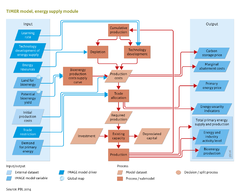Energy supply/Description: Difference between revisions
Jump to navigation
Jump to search
No edit summary |
No edit summary |
||
| Line 5: | Line 5: | ||
===Long-term depletion=== | ===Long-term depletion=== | ||
The depletion of fossil fuels (coal, oil and natural gas) and uranium is simulated on the basis of the assumption that their resources can be represented by a long-term supply cost curve, consisting of different resource categories with increasing costs levels. The model assumes that the cheapest deposits will be exploited first. For each region, there are 12 resource categories for oil, gas and nuclear fuels, and 14 categories for coal. | The depletion of fossil fuels (coal, oil and natural gas) and uranium is simulated on the basis of the assumption that their resources can be represented by a long-term supply cost curve, consisting of different resource categories with increasing costs levels. The model assumes that the cheapest deposits will be exploited first. For each region, there are 12 resource categories for oil, gas and nuclear fuels, and 14 categories for coal. | ||
A key input for each of the fossil-fuel and uranium supply submodels is that of fuel demand (i.e. fuel used in final energy and conversion processes). Additional input consists of conversion losses in refining, liquefaction, conversion, and energy use within the energy system. In the submodels, it is indicated how demand can be met by supply, both within a region and from other regions through interregional trade. | A key input for each of the fossil-fuel and uranium supply submodels is that of fuel demand (i.e. fuel used in final energy and conversion processes). Additional input consists of conversion losses in refining, liquefaction, conversion, and energy use within the energy system. In the submodels, it is indicated how demand can be met by supply, both within a region and from other regions through interregional trade. | ||
{{FormulaTemplate|Table_ES}} | |||
The table above provides an overview of the fossil-fuel categories, for illustrational purposes here aggregated into only 5 categories for each fuel. Each category has its own typical production costs. The table indicates that the assumptions for oil and natural gas supply limit this supply to only 2 to 8 times the 1970–2005 production level, for all categories, up to current reserves of unconventional sources. Production estimates on other unconventional resources are much larger, albeit very speculative. For coal, even current reserves amount to almost 10 times the production level of the last three decades. For all fuels, the model assumes that, if prices would increase (or spectacular technology development takes place), the energy could be produced in the higher-cost resource categories. The values in the table above represent medium estimates in the model. The model can also use higher or lower estimates in the scenarios. The final production costs in each region are determined by the combined influence of resource depletion and learning-by-doing (for more information see backrgound information on [[Technical learning and depletion|resource depletion and 'learning by doing']]. | The table above provides an overview of the fossil-fuel categories, for illustrational purposes here aggregated into only 5 categories for each fuel. Each category has its own typical production costs. The table indicates that the assumptions for oil and natural gas supply limit this supply to only 2 to 8 times the 1970–2005 production level, for all categories, up to current reserves of unconventional sources. Production estimates on other unconventional resources are much larger, albeit very speculative. For coal, even current reserves amount to almost 10 times the production level of the last three decades. For all fuels, the model assumes that, if prices would increase (or spectacular technology development takes place), the energy could be produced in the higher-cost resource categories. The values in the table above represent medium estimates in the model. The model can also use higher or lower estimates in the scenarios. The final production costs in each region are determined by the combined influence of resource depletion and learning-by-doing (for more information see backrgound information on [[Technical learning and depletion|resource depletion and 'learning by doing']]. | ||
Revision as of 16:59, 10 December 2013
Parts of Energy supply/Description
| Component is implemented in: |
|
| Related IMAGE components |
| Projects/Applications |
| Key publications |
| References |
